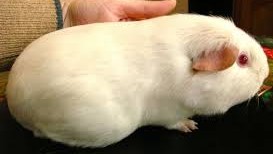This is Cavia porcellus, the domestic Guinea Pig. Cute, ain’t he? Belonging neither to the rodent nor pig families, this little grass-muncher is a popular pet in Europe and North America. He’s been domesticated for nearly 7,000 years, but he’s only been a pet for the last 500. In his native lands of South America, this little guy is an important staple in the family diet.
Wait a minute! People EAT guinea pigs!? Absolutely. Not only are they easy and inexpensive to raise, they are reportedly delicious pan-fried or roasted and served traditionally with a side of dumplings and sliced tomatoes.
Most Americans are horrified when they think of their adorable little Ralphie served up on a plate, so before my comments are bombarded by PETA members and over-zealous vegetarians, let me clear up a few myths.
1) Although equally edible, American guineas bred as pets are not the same as Peruvian pigs raised for food. For one, Peruvian guineas (also known commonly as “cavies”) are larger and far less friendly. A pet cavie may only yield 1.5 – 2 lbs of meat, if you’re lucky, while typical meat cavies average more like 2.5 – 4 lbs. So American pigs really aren’t worth the trouble in the long run.
2) Meat pigs are not cooked alive! I despise this misconception, but with the ever-growing cultural ignorance in our country, it happens. Guinea pigs are prepped much like chickens; they are killed as quickly as possible, flash-boiled in water for 30 seconds to one minute to remove the hair, then the body dressed-out (the organs removed) and either immediately cooked or quick-frozen to eliminate harmful bacteria.
3) “God will hate you forever!!!” Oh, I just love this misconceived comment because it inevitably crops up in just about every blog that features animals (especially small fuzzy ones) as food. It is made by “wannabe Christians,” often includes horrible grammar and too many exclamation marks, and is a dead ringer that the commentor has never read his/her Holy Bible. God understands humans as omnivores, otherwise, He would not have told Noah, right after he disembarked from the ark, “Every moving animal that is alive may serve as food for you. Just as I gave you the green vegetation, I give them all to you.” — Genesis 9:3.
There is absolutely nothing at all wrong with being a moralistic vegetarian or vegan. More power to you! But before you go blaming others for their natural eating habits, you might want to “remove the rafter from your own eye,” first. (Matthew 7:1-5)
So What Does Cuy (guinea pig meat) Taste Like?
According to aficionados, it is an all-dark meat similar in flavor to rabbit or the dark meat of a chicken. It is prepared fried, broiled, roasted, baked, stewed, or any other way one might prepare meat. It is high in protein and low in fat and cholesterol, making it a great potential meal for folks on a low-carb diet. However, I wouldn’t recommend running out and buying the first fat guinea pig you see – pet store pigs are raised on a commercial food, making them rather bland and tasteless. They’re also very expensive, costing an average $35 each.
All that said, if you want a crunchy cavy meal here in the US, and you’re not close to a Peruvian restaurant, you’ll have to raise them on your own. Despite cautions from reputable breeding sites such as the American Cavy Breeders Association (ACBA), and the American Rabbit Breeders Association, Inc., guinea pigs are natural-born breeders. After a long gestation period (about 68 days), they pop out 3 or 4 fully developed offspring, who are eating solid food in less than a week. Mere hours after giving birth, Momma’s good to go for another round. Female offspring are ready to breed as soon as four weeks. Care must be taken to ensure you don’t get more piggies than your larder can handle.
There are many stories of unsuspecting, but well-meaning pet owners who find themselves suddenly overrun and resorting to bashfully calling on the ASPCA or a local humane shelter to take away the surplus. Scanning Craigslist or checking in with the local animal shelter or Humane Society may yield suitable stock for starting a meat herd. However, guinea pigs are prone to many illnesses, so be sure to purchase only healthy, hardy animals and prepare to have a vet check them over. It is always well worth it in the long run.
Selecting Breeding Stock
Importing live guinea pigs from Peru is definitely not an option for a small-time hobby breeder like me, and there are not a lot of herds raised in the US for meat, so I’m basically starting from scratch with my own breeding program. While there is a lovely variety of colors and conformations among the pet guinea world, again, I’m not breeding for pets. After some research, this is my personal list of traits I’d be looking for to start up a meat herd:
1) Health. Most important over all else, I need strong, vigorous animals that will thrive in an indoor/outdoor environment and are resistant to disease. Healthy = Happy = Tasty.
2) Excellent Mothers. I want females who consistently produce larger (say up to a maximum 4 for now) litters, have great maternal instincts, and who give birth without complications. Pups raised by mothers with good instincts are more likely to survive and are less susceptible to disease.
3) Size. Important to a meat breed is how large they grow and how quickly they get there. This is where the selective breeding comes in. What I’ll be looking for are pups that grow to about 2 lbs. by the time they are four months old (based off a 1989 Agri Culture newsletter). The fastest growing females will become my new breeders, until I can work my way up to my goal of 4 lbs. in 4 – 6 months.
As a rule of thumb, never breed a large male to a small female! The result may be pups that are too large for the female to handle, causing serious complications that result in irreversible damage and/or death of the mother or her pups.
4) Temperament. Although I’m not breeding for personality, I still want animals that are easy to handle, as regular health inspections and vet checks are an absolute must. I also want to retire my boars and sows rather early, and sweet animals are more likely to find loving homes (and escape the freezer).
5) “Multi-purpose” Breeds. With the wide variety in fur types, there’s no reason I should not also breed for fur or hair. I would then supply a small niche market for crafters and artisans. Be warned, longer-haired varieties may need special attention and grooming.
I would look for white-coated animals – particularly the red-eyed white (REW). Personally, I do not see REWs as pets because of their origins as lab animals and their notoriety for poor eyesight and short life-spans. (This is why I do not own REW rats.) This makes them easier for me to raise them as food. Also, the white hair is easily dyed – a desirable quality for consumers. All I’m missing to make this herd perfect is a milking guinea! (Yar!)
What I definitely do not want, are feeder animals. Despite the tempting price (I recently saw some feeder guineas for sale on Craigslist for $5 each), animals intended for snake food are inbred and over-bred with no consideration towards health, happiness, or temperament. Why take the risk of having to destroy your entire stock due to disease when you just got started? Instead, spend the extra money and get cavies from a reputable breeder. I would prefer to purchase my stock from a cavy show, where I can look over many individuals myself.
Housing, Nutrition, and Care
Guinea Pigs thrive in surprisingly small spaces. Meat cavy in Peru are raised in pens, much like real pigs, or are allowed to roam in and out of the kitchen dining on grass and vegetable scraps. One advantage is
that once they establish a home base, they rarely wander far from it. So long as they have cover at least six inches high to duck under, they can avoid most predators. This makes them ideal to raise in an urban environment.
I want to raise my herd on the lush grass that grows here in the Midwest, supplementing their diet with timothy hay and fresh veggies. Because, like humans, they do not produce their own vitamin C, they are susceptible to scurvy. Foods such as broccoli, red bell peppers and citrus fruits are also needed in their diet.
I could keep them indoors, but I would need bedding such as straw or hardwood shavings, which are time consuming to maintain. I’d prefer to keep them outdoors in covered pens like the ones shown. Foxes, coyotes, raccoons, hawks, owls, snakes and dogs, and sometimes opossums are all predators that like cuy, too, so outdoor enclosures need to be secure, with plenty of places for the cavies to hide and feel safe.

A beautiful outdoor setup. I would build several of these and rotate my herds through them as needed to provide fresh fodder.
Commercial pet cages or rabbit hutches are not a good choice. Guinea pigs have delicate bones and sensitive paws that easily develop nasty sores (a condition called “bumblefoot”) if they are housed on wire floors. They are also not climbers so multi-level houses are also not good homes.
Some sources say guinea pigs can co-habitate with rabbits and chickens. Personally, I would not do this. Chickens like to peck at such docile creatures and rabbits tend to kick. Even dwarf bunnies are powerful enough to crush cavy bones.
A mobile chicken tractor is also a good option for grazing during the day, so long as they are put up into secure pens at night.
Long-Term Breeding Plan
Selectively breeding any animal takes time, research, experience, and patience. I do not expect to be stocking my freezer full of fat cavies anytime soon. The expense of doing this will not be in my favor until I’ve established reliable bloodlines and identified a suitable market to make this all worthwhile.
In the meantime, while I am still researching and planning, I will find a way to get in touch with other folks interested in breeding cuy. If there are enough folks interested, and I’m still serious about this in a few months, I would love to start up a support forum (provided one does not already exist). Starting a forum and getting others interested in this project can open up an opportunity to form mutually beneficial co-ops, which are ideal for small-scale breeders and farmers.
So if you are considering starting your own little backyard homestead, don’t overlook the guinea pig!
_____
Please note that the information in this article is not entirely complete. If you have further useful information to share on this topic, please feel free to comment. I would be interested in doing a follow-up article. Also, if this is also a project you would like to attempt, please leave a comment! I am very interested in connecting with other cuy enthusiasts!
Further Reading:
American Cavy Breeders Association — http://www.acbaonline.com/
Agri Cultures — The Guinea Pig as Meat Producer
Eat The Weeds – Guinea Pigs, Cavy, Cuy
Houston Chronicle — Importer wants guinea pigs on Houston menus












Recent Comments